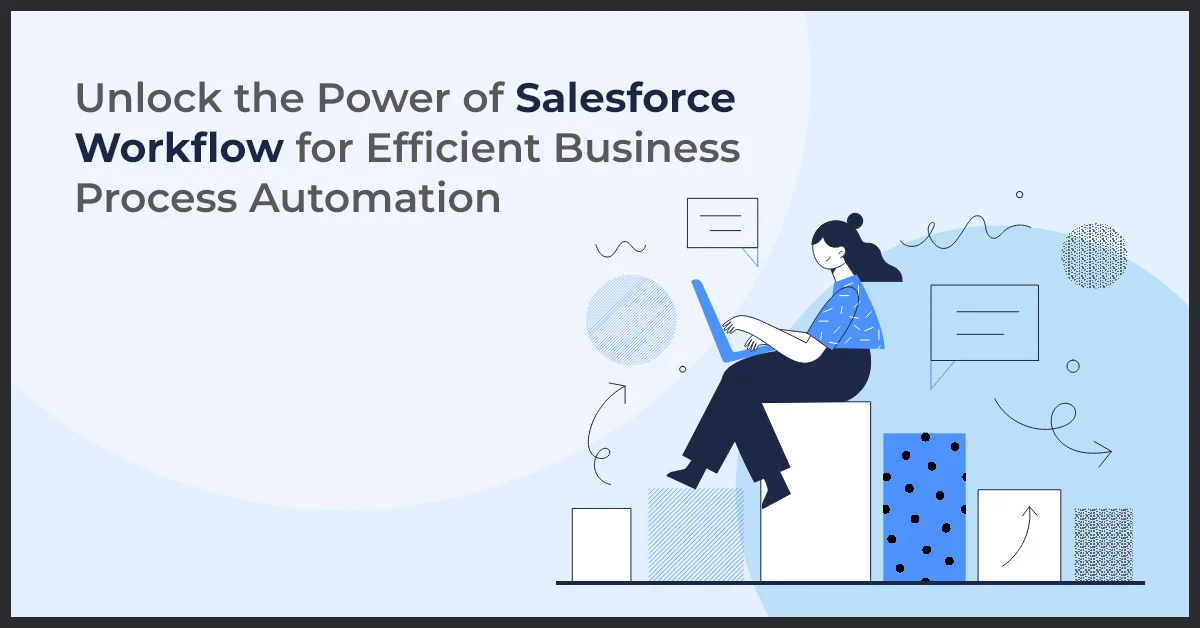Explore the Power of Salesforce Workflow for Efficient Business Process Automation

Published on: November 3, 2023
Updated on: July 09, 2024
626 Views
- Salesforce
11 min read
Welcome to our comprehensive guide on leveraging Salesforce Workflow to supercharge your business process automation. As a leading customer relationship management (CRM) platform, Salesforce offers robust tools and features to streamline your sales, marketing, and customer service operations. In this article, we'll explore the definition and significance of Salesforce Workflow, providing you with the knowledge and insights necessary to optimize your business processes and drive unparalleled efficiency.
Definition and Overview
Salesforce is a top-tier CRM platform that empowers businesses to manage and nurture customer relationships better. By centralizing customer data, enhancing collaboration, and providing powerful analytics capabilities, Salesforce enables organizations to streamline operations, increase productivity, and drive revenue growth.
In business process automation, Salesforce Workflow plays a pivotal role. Workflow refers to the automated series of actions and tasks that can be triggered based on predefined rules and criteria. This allows businesses to streamline repetitive tasks, eliminate manual processes, and ensure efficient execution of necessary operations. Through Salesforce Workflow, organizations can automate alerts, email notifications, field updates, and much more, ultimately freeing up their teams to focus on high-value activities while improving overall operational efficiency.
Understanding Salesforce Workflow Automation
Overview of Automation in Business Processes
Salesforce workflow automation plays a crucial role in automating business processes and tasks. Streamlining and automating repetitive or manual tasks helps reduce manual efforts and improve organizational efficiency.
With Salesforce workflow, businesses can automate various actions, such as updating records, sending email notifications, creating tasks, and more. This automation enables employees to focus on more critical tasks, increasing productivity and better resource utilization.
Business Process Management
Salesforce workflow automation is an essential tool for managing and optimizing business processes. It ensures that the right tasks are assigned to the right people at the right time, eliminating bottlenecks and improving workflow efficiency.
Businesses can define and enforce specific rules and criteria for automating processes with Salesforce workflow automation. This ensures that each step in the business process is executed correctly, reducing errors and enhancing the overall quality of work.
Process Automation Capabilities
Salesforce workflow automation offers a wide range of process automation capabilities. It can automate various processes, such as lead nurturing, opportunity management, case handling, and approval.
For example, with Salesforce workflow, organizations can automate the lead nurturing process by automatically sending follow-up emails and reminders to prospects. This helps keep the leads engaged and improves the chances of converting them into customers.
Process automation provided by Salesforce workflow automation also offers significant benefits in terms of time and cost savings. Businesses can reduce manual efforts and minimize errors by automating repetitive tasks, increasing efficiency and operational costs.
Pro Tip: When implementing Salesforce workflow automation, start with small, well-defined processes and gradually expand automation based on success and feedback. This incremental approach allows for smoother implementation and better adoption across the organization.
Components of Salesforce Workflow Automation
Workflow Rules
Workflow rules in Salesforce define specific criteria and actions that trigger workflows. By automating repetitive tasks and streamlining operations, workflow rules help improve efficiency and productivity.
Approval Processes
Salesforce workflow automation provides a framework for defining and managing approval processes. In business scenarios such as deal approvals and document reviews, it ensures timely and accurate approval by the relevant parties.
Task Management
Salesforce workflow automation assists in managing and assigning tasks to individuals or teams. It enables efficient task progress tracking and ensures timely completion, enhancing overall productivity.
Notifications and Alerts
Salesforce workflow automation allows setting up notifications and alerts for critical events or changes. Prompt user notifications enable efficient decision-making and task management by informing users in real-time.
Workflow Actions
Salesforce workflow provides various actions that can be executed, including field updates, email alerts, outbound messages, and task creation. These workflow actions contribute to process automation and improvement of productivity.
Workflow Templates
Pre-built Salesforce workflow automation templates can be customized to suit specific business needs. Utilizing these templates saves time and effort in workflow creation, enhancing efficiency and effectiveness.
Pro Tip: Regularly review and refine your workflow automation processes to adapt to changing business needs and optimize efficiency. Continuous improvement ensures your workflows align with evolving requirements and deliver maximum value to your organization.
Reporting and Analytics with Salesforce Workflow Automation
As a business, it is crucial to track and report on the progress and performance of your workflows. This lets you clearly understand your processes function and identify improvement areas.
Data-driven decision-making is a key aspect of modern business strategies. With Salesforce workflow automation, you can gather essential data and insights that help you optimize your processes and make informed decisions. Analyzing the data captured through the workflow allows you to identify bottlenecks, streamline operations, and maximize efficiency.
Importance of Tracking and Reporting
Tracking and reporting provide a wealth of benefits for businesses. It allows you to:
Monitor the progress and status of workflows in real-time
Identify potential issues or delays in the workflow
Measure the performance and effectiveness of your processes
Identify areas for improvement and optimization
By staying on top of your workflows through tracking and reporting, you can ensure that business operations run smoothly and efficiently. It also enables you to make data-driven decisions for continuous process improvement.
Salesforce Workflow Automation and Data Insights
Salesforce Workflow offers robust reporting and analytics capabilities, providing deep insights into your business processes. You can generate comprehensive reports and dashboards that showcase key metrics and performance indicators.
These data insights derived from Salesforce workflow automation can contribute to your overall business success in several ways:
Identifying trends and patterns: By analyzing the data captured through workflows, you can identify trends and patterns influencing business outcomes. This helps you align your strategies accordingly and make data-driven decisions.
Measuring efficiency and productivity: Salesforce workflow automation allows you to measure the efficiency and productivity of your workflows. This enables you to optimize processes, eliminate bottlenecks, and improve overall business performance.
Tracking customer interactions: Salesforce workflow automation allows you to track and analyze customer interactions at each workflow stage. This valuable data helps you enhance customer experiences, identify upsell opportunities, and strengthen customer relationships.
With Salesforce Workflow's reporting and analytics capabilities, you can gain actionable insights that drive your business forward.
Pro Tip: Regularly review and analyze your workflow reports to identify trends, bottlenecks, and areas for improvement. You can optimize your workflows, enhance efficiency, and drive better business outcomes by leveraging these insights.
Salesforce Workflow Automation: Key Features and Benefits
As mentioned earlier, Salesforce workflow automation has many key features that empower businesses to streamline their processes and achieve greater efficiency. These features include:
- Automated Email Alerts and Field Updates
- Task Assignment and Escalation Rules
- Time-Based Workflow Actions
- Visual Workflow Designer
- Approval Processes
- Real-Time Analytics and Reporting
- Integration with Other Salesforce Products
These features allow businesses to automate their day-to-day operations, reduce manual efforts, and ensure consistent and accurate data across various departments.
Moreover, Salesforce workflow automation benefits organizations by enhancing their performance and customer experience. Some of the highlighted benefits include:
Reduced Manual Efforts and Human Errors: With automated workflows, repetitive tasks are handled seamlessly, eliminating manual intervention and minimizing the risk of errors.
Improved Task Management: Salesforce workflow automation enables efficient task assignment, escalation, and tracking, ensuring timely completion and enhanced team collaboration.
Streamlined Operations: By automating business processes, organizations can achieve higher operational efficiency, faster response times, and optimized resource allocation.
Enhanced Customer Experience: With streamlined workflows, businesses can provide faster and more personalized responses to customer inquiries and requests, improving satisfaction and loyalty.
Better Decision-Making: Real-time analytics and reporting capabilities enable businesses to gain insights into workflow performance, identify bottlenecks, and make data-driven decisions for process optimization.
Seamless Integration: Salesforce Workflow seamlessly integrates with other Salesforce products, allowing businesses to leverage a comprehensive ecosystem to meet their needs and achieve end-to-end process automation.
In conclusion, Salesforce workflow automation offers powerful features and compelling benefits that empower businesses to simplify processes, boost productivity, and deliver exceptional customer experiences. By harnessing Salesforce Workflow's potential, organizations can accelerate their growth, drive operational excellence, and stay ahead in today's competitive business landscape.
Pro Tip: Prioritize clear communication and training for your team when implementing Salesforce workflow automation. Ensuring everyone understands how workflows function and their role within them fosters smoother adoption and maximizes the benefits of automation.
Salesforce Workflow Automation: Developers and Product Integration
Developers are crucial in maximizing Salesforce Workflow's potential by integrating it with other products. This integration paves the way for a seamless and unified customer relationship management (CRM) experience. Let's explore how Salesforce workflow automation integrates with various Salesforce products and the benefits it brings.
Integration with Salesforce Products
Salesforce Workflow easily integrates with products like Customer 360 and Enterprise. Businesses can optimize workflow management and enhance CRM capabilities by leveraging these integrations.
Customer 360 Integration: Salesforce workflow automation integrates seamlessly with Customer 360, allowing businesses to streamline their customer data and gain a holistic view of their customers. This integration enables automated processes, triggers, and actions based on data from Customer 360, enhancing overall efficiency and improving customer satisfaction.
Enterprise Integration: Salesforce workflow automation integration with Enterprise empowers businesses to automate their complex workflows across different departments and teams. This integration facilitates efficient collaboration, eliminates redundant tasks, and increases productivity by automating repetitive processes.
The integration with other Salesforce products provides businesses with a unified CRM experience. Data from multiple sources is seamlessly connected, unlocking powerful insights and driving informed decision-making across the organization.
Developer Resources and Support
Salesforce recognizes the importance of developers harnessing Salesforce workflow automation's capabilities. To support developers in utilizing and customizing workflow features, Salesforce provides various resources and support.
Documentation: Salesforce offers comprehensive documentation that provides detailed insights into the features, functionalities, and best practices related to Salesforce workflow automation. Developers can refer to this documentation to understand the intricacies of workflow management and explore advanced customization options.
Tutorials: Salesforce offers interactive tutorials and guides to help developers learn how to leverage workflow features effectively. These tutorials provide:
- Step-by-step instructions.
- Sample code snippets.
- Real-world use cases to empower developers to implement and customize workflows according to their business requirements.
Developer Communities: Salesforce boasts a vibrant community of developers who actively share knowledge, insights, and best practices related to Salesforce workflow automation. Developers can leverage these communities to seek help, exchange ideas, and collaborate with industry peers, enhancing their proficiency and staying updated with the latest trends in workflow management.
With these resources and support, developers can confidently explore Salesforce workflow automation's full potential, tailor it to their needs, and create efficient automated processes that drive organizational growth.
Key Takeaways
- Salesforce workflow automation streamlines business processes by automating repetitive tasks, reducing manual efforts, and improving overall efficiency. It empowers employees to focus on more critical tasks, enhancing productivity and resource utilization.
- Integrating Salesforce workflow automation with other Salesforce products, such as Customer 360 and Enterprise, provides businesses with a unified CRM experience. This integration enables seamless data connectivity, automated processes, and better decision-making across the organization.
- Collaboration between developers and stakeholders is essential for maximizing the potential of Salesforce workflow automation. Involving developers early in planning ensures seamless integration, optimal feature utilization, and efficient automated processes that drive organizational growth.
Conclusion
After exploring the various aspects of Salesforce workflow automation, it is clear that this tool plays a vital role in automating business processes and improving efficiency. Throughout this content, we discussed the introduction, understanding, components, reporting and analytics, key features and benefits, and developers and product integration of Salesforce Workflow.
Businesses can streamline operations, reduce manual tasks, and increase productivity using Salesforce workflow automation. Salesforce's workflow automation capabilities allow organizations to save time and resources, ultimately leading to improved customer experiences and increased revenue.
We encourage readers to explore and leverage Salesforce Workflow to meet their business needs. Whether you are a small business owner, a sales professional, or a team manager, Salesforce Workflow has the potential to transform your operations and drive success.
Do you need assistance with Salesforce Workflow Automation? Growth Natives boasts of having the most competent Salesforce Experts to assist you with your Salesforce Automation requirements. Write to us at info@growthnatives.com to get started.
Frequently Asked Questions
Salesforce workflow automation refers to automating business tasks and processes within the platform. It allows users to define rules and criteria that trigger automated actions, such as updating records, sending email notifications, or assigning tasks based on specific conditions.
Three basic components of workflow in Salesforce: The three basic components of workflow in Salesforce are:
- Workflow Rules: Define the conditions that trigger automated actions.
- Workflow Tasks: Specify the actions to be performed when workflow rules are met.
- Workflow Actions: Determine the actions to be executed, such as sending email alerts or updating field values.
Types of automation in Salesforce: Salesforce offers various types of automation, including:
- Workflow Rules
- Process Builder
- Flow
- Apex Triggers
The main purpose of workflow automation is to streamline business processes, reduce manual efforts, and improve efficiency by automating repetitive tasks and enforcing consistent actions based on predefined rules and criteria.
Yes, Salesforce can send automated emails as part of workflow automation. Users can configure workflow rules to trigger email alerts based on specific conditions, such as record changes or time-based events.
Salesforce Process Automation is the collective term for tools and features that automate business processes within the Salesforce platform. This includes Workflow Rules, Process Builder, and Flow, which allow users to define and automate complex processes without writing code.
Yes, Salesforce can be automated using various tools and features available within the platform, such as Workflow Rules, Process Builder, Flow, and Apex Triggers. These tools enable users to automate repetitive tasks, enforce business rules, and streamline processes without extensive coding.



